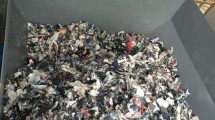Abstract
The quality and quantity of coke oven gas depend on the properties of charged coal blend and cokemaking technology. In general, the raw coke oven contains naphthalene vapor in the range of 1500–2000 g per 100 Nm3 of gas which starts condensing directly into the solid form if the temperature of the gas goes down. Therefore, removal of naphthalene from coke oven gas is vital for ease of transporting through pipelines and its use as fuel. The removal process consists of scrubbing system followed by a stripping system. The scrubbing system requires efficient wash oil for absorbing the naphthalene, and the rich wash oil needs to be stripped for recycling the wash oil in the scrubbing system. In the present study, four different sources of wash oils were chosen for detailed characterization followed by aspen simulation. The stripping of naphthalene from rich wash oils shows that the HWO has better efficiency, followed by CTWO. The SWO and IWO are also having satisfactory performance. The SWO contains less sulfur and specific gravity compared to CTWO, HWO and IOWO. The characterization temperature of SWO at 5% distilled is very high (347.5°C) as compared to IOWO (330.6°C), HWO (280.3°C), and CTWO (252.1°C). Also, the temperature at 95% distilled is 373.3°C is low compared to other tested oils. The result shows that properties of SWO oil are superior for absorbing naphthalene.

Similar content being viewed by others
REFERENCES
Lowry, H.H., Chemistry of Coal Utilization, Chichester: Wiley, 1945, vol. 2.
Vshivtsev, V.G. and Nazarov, V.G., Removing tar and naphthalene fog from coke-oven gas, Koks Khim., 1984, no. 11, pp. 22–27.
Nazarov, V.G., Vshivtsev, V.G., and Simonov, S.P., Koks Khim., 1982, no. 4, pp. 29–31.
Stetsenko, E.Ya. and Suryadnyi, V.I., Koks Khim., 1978, no. 7, pp. 38–39.
Gunntheroth, H., Dechema Monogr., 1963, vol. 48, pp. 329–349.
Korzh, E.V., Lebedyuk, G.K., and Gazov, P., Moscow, 1981, vol. 3.
Kogan, B.E. and Kuzh’mina, E.Ya., On the quality of wash oil, Koks Khim., vol. 3, pp. 34–36.
Poroshin, B.K., Bogorodskii, D.V., and Shkoller, M.B., Koks Khim., 1977, no. 8, pp. 32–34.
Tumarkin, L.A., Orlov, M.L., and Goldin, I.A., Koks Khim., 1964, no. 4, pp. 45–50.
Privalov, V.E., Kogan, B.E., and Sokolov, B.M., The Chemical Products of Coking, Sverdlovsk, 1965, vol. 3, pp. 103–118.
Gurtovnik, P.F., Dubrovskaya, D.P., and Forer, E.A., Koks Khim., 1970, no. 6, pp. 43–51.
Levedeva, G.N., Investigation of the Chemical Products of the Coking of Coal, Moscow: Metallurgizdat, 1947, vol. 4, pp. 80–100.
Mariich, L.I. and Ambrozevich, F.N., The quality of absorbing oil, Koks Khim., 1981, no. 9, pp. 32–35.
Mariich, L.I. and Lenkevich, Zh.K., Koks Khim., no. 5, pp. 34–41.
Mariich, L.I. and Lenkevich, Zh.K., Koks Khim., no. 7, pp. 32–38.
Mariich, L.I., Gazovaya khromatografiya v kontrole koksokhimicheskogo proivodstva (Gas Chromatography in Coke Oven By-Product Monitoring), Moscow: Metallurgiya, 1979.
Chuishchev, V.M., Kononenko, V.E., and Nikonyuk, F.P., On the quality of coal wash oil, Koks Khim., 1986, no. 9, pp. 50–51.
Meier-Grolmann, and Oppelt, F.W., Oel Kohle, no. 36, p. 457.
Mashek, V. amd Pavelnkova, Yakh E.Z., Koks Khim., no. 9, pp. 42–47.
Lazorin, S.N. and Stetsenko, V.Ya., Proizvodstvo syrogo benzola (Crude Benzene Production), Kiev: Tekhnika, 1969.
Shapiro, M.D. and Zhokh, M.P., Koks Khim., 1962, no. 4, pp. 34–38.
Kattwinkle, R., Gas Wasserfach., 1924, vol. 67, pp. 474–478.
Pinchugov, V.N., Kurkin, V.V., Deis, A.A., and Zarechnev, A.V., Operation of a plant for regeneration of wash oil with flame heating, Koks Khim., 1988, no. 12, pp. 32–34.
Hsu, T.-H., Corrosion and blockage problems at benzene recovery plant, Proc. Iron Making Conf., Warrendale, Pa: Iron Steel Soc., 1999, pp. 247–254.
Lin, S.-L., Shen, J.-F., and Chen, W.-C., Reducing the organic deposit in coke oven gas pipelines of steel plant, Proc. Iron Making Conf., Warrendale, Pa: Iron Steel Soc., 1999, pp. 295–301.
Razgonov, V.A. and Ivantsov, V.A., Improving the processing schemes of recovery divisions, Koks Khim., 1984, no. 9, pp. 21–24.
Stetsenko, E.Ya., On problems of improving the purification of coke oven gas, Koks Khim., 1983, no. 1, pp. 15–18.
Kulyasova, S.V., Mikhno, S.I., Koptev, G.P., and Morokhova, S.N., A survey of the operation of the coke oven gas final cooling cycle, Koks Khim., 1981, no. 11, pp. 26–28.
Sinolyukov, N.K., Method for increasing degree of purification of coke oven gas from hydrogen sulfide, Koks Khim., 1990, no. 1, pp. 25–26.
Author information
Authors and Affiliations
Corresponding authors
About this article
Cite this article
Manish Kumar, Tiwari, H.P. Assessment of Naphthalene Absorption Efficiency from Coke Oven Gas. Coke Chem. 63, 500–512 (2020). https://doi.org/10.3103/S1068364X20100026
Received:
Revised:
Accepted:
Published:
Issue Date:
DOI: https://doi.org/10.3103/S1068364X20100026




